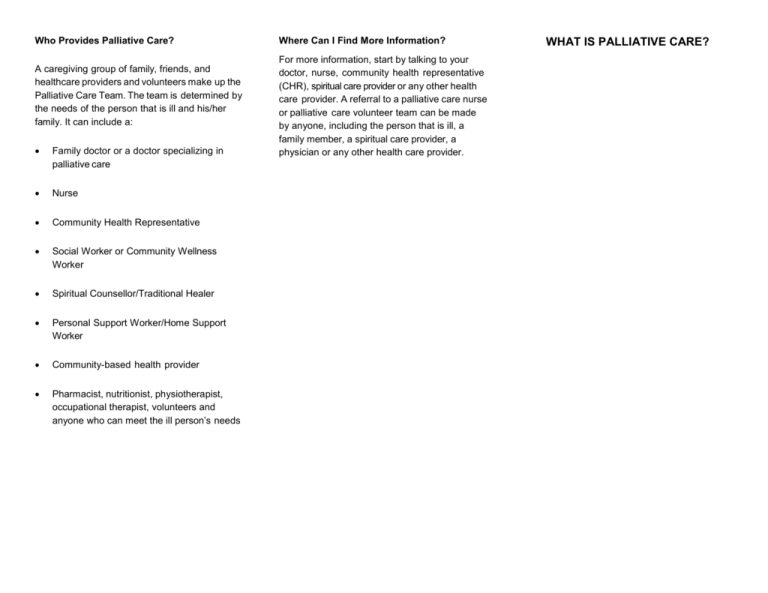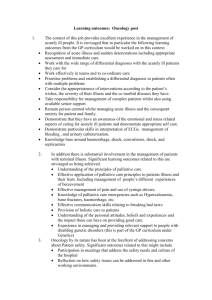What is Palliative Care template (MS Word) - Improving End-of
advertisement

Who Provides Palliative Care? A caregiving group of family, friends, and healthcare providers and volunteers make up the Palliative Care Team. The team is determined by the needs of the person that is ill and his/her family. It can include a: Family doctor or a doctor specializing in palliative care Nurse Community Health Representative Social Worker or Community Wellness Worker Spiritual Counsellor/Traditional Healer Personal Support Worker/Home Support Worker Community-based health provider Pharmacist, nutritionist, physiotherapist, occupational therapist, volunteers and anyone who can meet the ill person’s needs Where Can I Find More Information? For more information, start by talking to your doctor, nurse, community health representative (CHR), spiritual care provider or any other health care provider. A referral to a palliative care nurse or palliative care volunteer team can be made by anyone, including the person that is ill, a family member, a spiritual care provider, a physician or any other health care provider. WHAT IS PALLIATIVE CARE? Palliative Care is a special type of healthcare that provides care, comfort and support to individuals who are living with a life threatening Caregiver support ( including family and community care providers) illness and their families Support and advice can be provided to family caregivers, as well as community-based care providers on making the person that is ill feel more comfortable. It is for people of all ages. Its focus is on the person and not the disease. It is about improving the quality of life at a time when the goal is not to cure. Palliative care involves a wide range of services that can be personalized to meet the needs of Volunteer support Volunteers may be available to provide support services such as companionship, provide relief for the caregiver and offer transportation. the person living with a terminal illness and their family. These services may vary from place to Bereavement support place, but generally, include: Grief support is available to help the family work through emotions and grief regarding the illness and death of a loved one. Pain and symptom management Family doctors or doctors who specialize in Links to resources such as nausea, loss of appetite, vomiting, Other programs may be available to the person receiving palliative care depending on what services are present in your area. For example, home care provides a variety of services to help take care of the family and home; ‘Meals on Wheels’ programs provide nutritious meals that can be delivered right to the home. difficulty sleeping, etc. Home visits by a nurse may also be available. Social and emotional support Support can be made available to help deal with feelings, such as fear and grief or concerns about the illness. Spiritual support Arrangements for spiritual support can be made whether the person is at home, in hospital, or in a long-term care facility. Palliative care may be provided in a variety of settings: Home Home is where most people prefer to live when they have a terminal illness. Home provides a comfortable, private, informal setting that is familiar for the person who is ill, and allows the caregivers, family members and friends to visit as often as they like. Hospitals Hospitals may provide a sense of security to the person requiring palliative care as they are able to provide direct access to doctors, nurses and other health care providers. Some hospitals may even have a palliative care unit. palliative care can help with pain and symptoms constipation, shortness of breath, fatigue, Where is Palliative Care Provided? Long-term care facilities Long-term care facilities, such as nursing homes, may be used for short periods of time to help control pain and symptoms or to provide respite to the caregiver.








